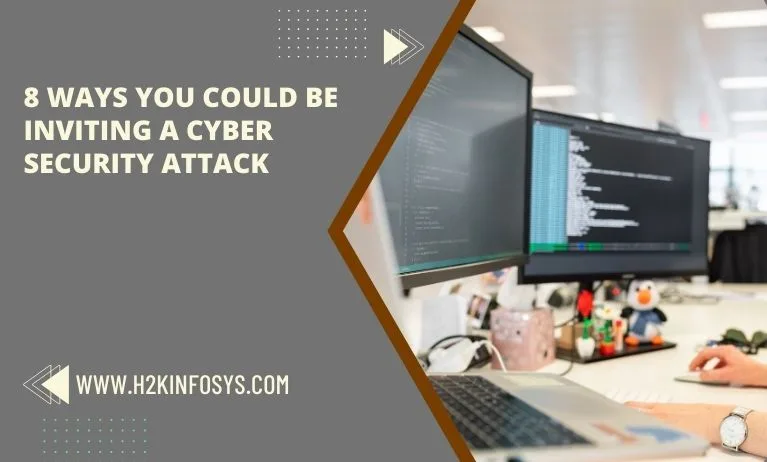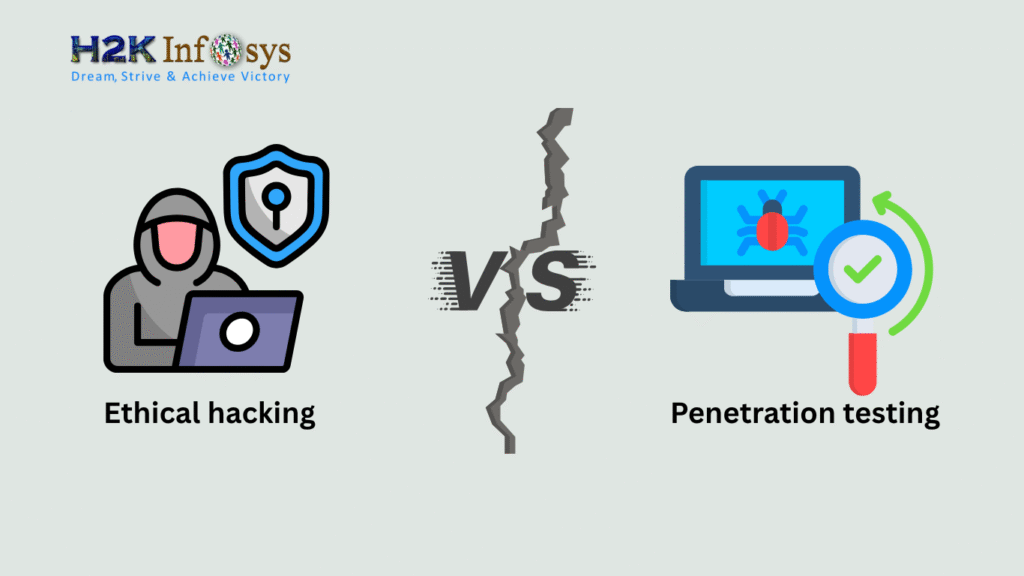Introduction
You don’t have to be a hacker to cause a Cyber Security attack; sometimes, poor digital habits are enough to invite one.
Whether you’re an individual, employee, or business owner, your daily actions might be unknowingly creating vulnerabilities. A Cyber Security attack can occur from something as simple as clicking a malicious email or connecting to an insecure network.
In this blog, we reveal eight critical behaviors that increase your risk of a Cyber Security attack, along with real-world examples and prevention strategies. By the end, you’ll understand how to reduce your risk and why Cyber Security training and placement programs, like those at H2K Infosys, are more important than ever.
1. Weak or Reused Passwords: A Gateway for Hackers
Why This Invites a Cyber Security Attack
Hackers exploit weak or reused passwords using automated tools like brute-force or credential-stuffing programs. If your password is compromised in one account, it could lead to a full-blown Cyber Security attack across your digital presence.
How to Defend Yourself
- Use passphrases or combinations of upper/lowercase letters, numbers, and symbols.
- Enable multi-factor authentication (MFA).
- Learn best practices through Cyber Security training courses that emphasize secure password policies.
2. Clicking on Suspicious Links or Attachments
The Threat of Phishing and Malware
Phishing emails are one of the most effective ways cybercriminals initiate a Cyber Security attack. Once clicked, these links may install malware, keyloggers, or ransomware without your knowledge.
What You Can Do
- Don’t click links in emails from unknown senders.
- Verify with the sender through a secondary channel.
- Gain phishing awareness through Cyber security courses with placement that simulate attack scenarios.
3. Ignoring System and Software Updates
Outdated Software Equals Open Doors
Running outdated software is one of the fastest ways to invite a Cyber Security attack. These programs often have known vulnerabilities that hackers specifically target.
How to Stay Safe
- Set your system to auto-update.
- Use tools to track patch statuses.
- Include patch management lessons in your Cyber security training and placement.
4. Using Public Wi-Fi Without Protection
The Risk of Unsecured Networks
A public Wi-Fi connection might be convenient—but it’s also an ideal setting for a Cyber Security attack. Attackers can perform man-in-the-middle (MITM) attacks, intercepting your data.
What You Should Do
- Avoid logging into sensitive accounts on public networks.
- Use VPNs to encrypt your traffic.
- Learn network security strategies in Cyber Security training near me programs.
5. Poor Employee Cyber Hygiene
Why People Are the Weakest Link
Employees are often the unintentional cause of a Cyber Security attack. From falling for phishing emails to connecting unauthorized devices, a single mistake can compromise an entire organization.
How to Strengthen Defenses
- Conduct regular training sessions.
- Limit access to sensitive systems.
- Enroll teams in Cyber security training courses to promote better practices.
6. No Backup = Higher Ransomware Risk
Why This Makes You a Target
Ransomware thrives where backups are missing or outdated. Without copies of your data, you’re left with little choice but to pay or lose everything in a Cyber Security attack.
Steps for Protection
- Automate cloud and physical backups.
- Test backups regularly.
- Explore backup strategies as part of your Cyber security course and job placement curriculum.
Excessive Access Privileges
More Access = More Risk
When users have more access than necessary, it becomes easier for attackers to execute a Cyber Security attack. Compromised admin accounts can be used to manipulate systems, steal data, or spread malware.
How to Prevent This
- Implement least-privilege policies.
- Regularly review user roles.
- Learn to apply RBAC (role-based access control) in Cyber security training.
Lack of Cyber Security Awareness or Education
The Biggest Vulnerability: Lack of Training
The most damaging Cyber Security attack often stems from the simplest human error. Whether it’s opening an infected file or ignoring a security warning, ignorance is a major vulnerability.
Your Best Defense
- Start or advance your career through Cybersecurity training and job placement programs.
- Focus on practical skills like penetration testing, network security, and secure coding.
- Stay updated on the latest threats through ongoing education.
Spotlight: Why a Cyber Security Attack Happens
A Cyber Security attack isn’t random. It’s often the result of identifiable and avoidable weaknesses. In many cases, these attacks follow a clear pattern:
- Reconnaissance (gathering data)
- Infiltration (gaining unauthorized access)
- Exploitation (stealing or damaging data)
- Covering tracks (erasing evidence)
Understanding these stages helps security professionals recognize early signs and prevent damage. That’s why Cyber security training courses emphasize real-world simulations and attack detection strategies.
The Rising Demand for Cyber Security Experts
According to Cybersecurity Ventures, the global cost of Cyber Security attacks is expected to reach $10.5 trillion by 2025. This threat surge has caused demand for cybersecurity professionals to skyrocket.
Roles that await skilled professionals include:
- Cybersecurity Analyst
- Threat Intelligence Specialist
- Security Operations Center (SOC) Analyst
- Vulnerability Assessor
- Incident Responder
Whether you’re switching careers or expanding your IT role, Cyber security training and placement programs ensure you’re prepared to defend organizations from all forms of Cyber Security attack.
How H2K Infosys Prepares You for Real-World Cyber Security Challenges
At H2K Infosys, we don’t just offer theory—we focus on real-world readiness. Our Cyber Security training courses include:
- Hands-on labs and real-time simulation environments
- Cyber security certifications preparation
- Career support including resume reviews and interview coaching
- Mentorship from experienced professionals
And most importantly, our Cyber security courses with placement connect learners to employers looking for fresh talent in this high-demand field.
Key Takeaways
- A Cyber Security attack can result from simple mistakes like clicking a suspicious link or ignoring system updates.
- Awareness and proactive behavior are the most effective defenses.
- Upskilling through Cyber security training near me programs builds confidence and employable skills.
- Employers now prioritize candidates who understand how to detect, mitigate, and respond to evolving threats.
- Certification, practical knowledge, and real-world project experience are essential for those aiming for cybersecurity careers.
Conclusion: Take Control of Your Digital Safety
Every digital action you take can either invite or prevent a Cyber Security attack. Be the defense, not the vulnerability.
Join H2K Infosys’ Cyber Security training and job placement programs today and gain the skills to protect systems, data, and careers—starting with your own.

























